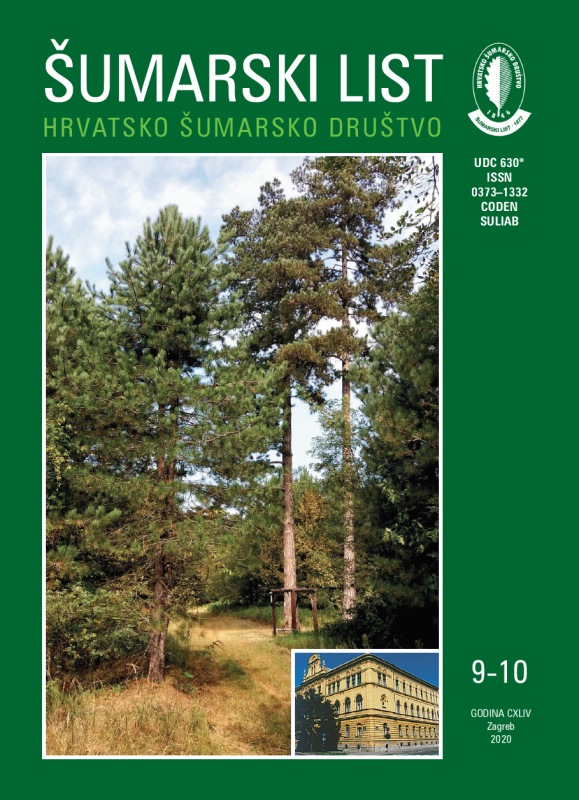
broj: 9-10/2020
pdf (6,75 MB) |
|
||||||||||||||
| RIJEČ UREDNIŠTVA | ||
| Uredništvo | ||
| How do we manage forests of small owners/holders in the Republic of Croatia pdf HR EN | 441 | |
| IZVORNI ZNANSTVENI ČLANCI | ||
| Mara Marić, Ivana Vitasović-Kosić | UDK 630* 270 + 232.1 (001) https://doi.org/10.31298/sl.144.9-10.1 | |
| Horticultural species of the island of Lokrum in the period of archduke Maximilian of Habsburg (1859–1869) and their current state pdf HR EN | 443 | |
| Martin Bobinac, Siniša Andrašev, Nikola Šušić, Andrijana Bauer-Živković, Đura Jorgić | UDK 630* 561 (001) https://doi.org/10.31298/sl.144.9-10.2 | |
| Growth and structure of italian alder (Alnus cordata /Loisel./ Duby) linear plantation at age 11 and 16 years at Fruška gora (Serbia) pdf HR EN | 455 | |
| Hanife Erdogan Genç, Ali Ömer Üçler | UDK 630* 232.3 (001) https://doi.org/10.31298/sl.144.9-10.3 | |
| Seed dormancy removal treatments and germnaton characterstcs of Acer trautvetteri Medvedev seeds pdf HR EN | 465 | |
| PRETHODNO PRIOPĆENJE | ||
| Antonio Vidaković, Marilena Idžojtić, Tonko Megyery, Dragan Turk, Igor Poljak | UDK 630* 272 https://doi.org/10.31298/sl.144.9-10.4 | |
| Kralj Petar Krešimir IV. park in Zagreb – woody plants pdf HR EN | 475 | |
| SUMMARY The Park Kralj Petar Krešimir IV was constructed in the period from 1937 to 1938, and was the first modern city park in the country. The park was divided into two parts by a road. The southern part of the park was designed as a “more naturally” shaped space dominated by the central grassland, whereas the north, smaller unit, was divided into three parts: a flower garden for grown-ups, the central parterre, and a children’s playground. Despite it being a large and important traffic junction nowadays, due to its lush vegetation it managed to preserve its intimate and meditative character used by many citizens to “escape” into the nature. In order to establish the current status of the woody plants on the territory of the Kralj Petar Krešimir IV Park in Zagreb, a dendrological analysis was performed and the current status of woody plants was compared to the status from 1962 and 1995. The plants were identified in the period from the summer of 2018 to the summer of 2019, and the paper includes an analysis of the following data: the number of individual taxa (species, subspecies, varieties, hybrids and cultivars), family affiliation, area, habitus and leaf duration, color of flowers, time of flowering, fruits and the number of autochthonous and allochthonous taxa. There were a total of 122 taxa recorded in the garden, distributed within 36 families: 83 species (six gymnosperms and 77 angiosperms), two subspecies (both angiosperms), 30 cultivars (one gymnosperm and 29 angiosperms), six hybrids (all angiosperms) and one variety (angiosperm). The genera with the most taxa are: Acer L. - maples (9), Prunus L. – plums (6), Berberis L. – holly grapes and Lonicera L. – honeysuckles (5), and Cornus L. – dogwoods and Spiraea L. – bridal wreaths (4). The number of taxa increased by 40 compared to 1962, and by 29 compared to 1995. There are 28 autochthonous taxa, and of the allochthonous ones, most are Asian and North American. According to leaf duration, the park is dominated by deciduous taxa, and as for the habitus, trees and shrubs are equally represented. The park is also home to numerous species and cultivars of flowering shrubs and trees which complement the area with their decorative flowers all year round. Despite the fact that in comparison with different arboreta and botanical gardens the park does not contain more significant woody taxa, nevertheless the trees of ginkgo, plane, common persimmon and Amur cork tree stand out, present in the park since its establishment and constituting an important segment of its visual identity. The Kralj Petar Krešimir IV Park is one of the rare urban parks in Zagreb which has remained well preserved to this day, and its qualities which had led to the status of a monument of park architecture must be preserved to make the public benefit provided by the park also available to future generations. Key words: woody plants; dendrological analysis; trees and shrubs; horticulture; urban green spaces | ||
| Miroslav Benko | UDK 630* 226 https://doi.org/10.31298/sl.144.9-10.5 | |
| Systematic monitoring of the conversion of pedunculate oak (Quercus robur L.) and sessile oak (Quercus petraea L.) seedlings with regard to different planting methods pdf HR EN | 485 | |
| PREGLEDNI ČLANCI | ||
| Margarita Bego | UDK 630* 832 + 836 https://doi.org/10.31298/sl.144.9-10.6 | |
| From forest to marquetry pdf HR EN | 497 | |
| Tomislav Poršinsky, Josip Matas, Dubravko Horvat, Andreja Đuka | UDK 630* 307 https://doi.org/10.31298/sl.144.9-10.7 | |
| Tyres of forestry vehicles pdf HR EN | 509 | |


